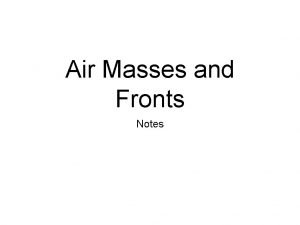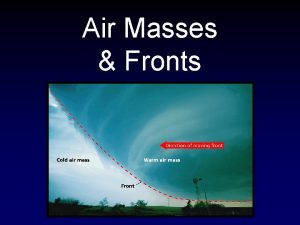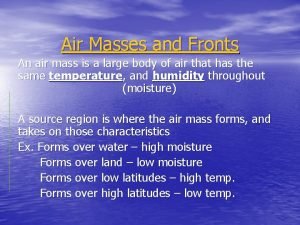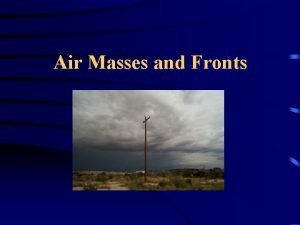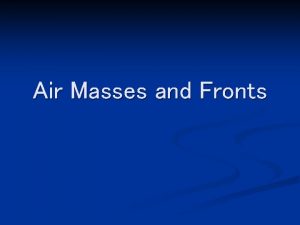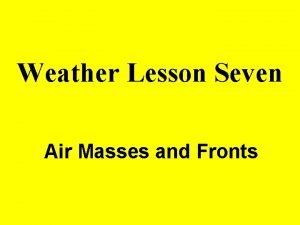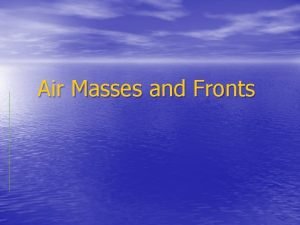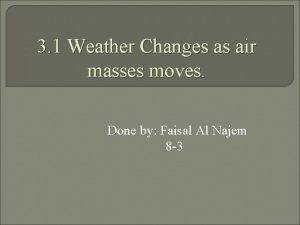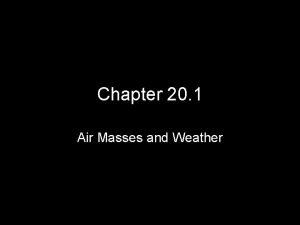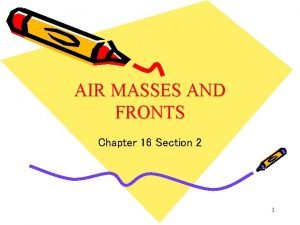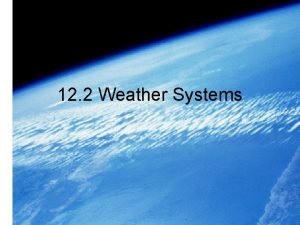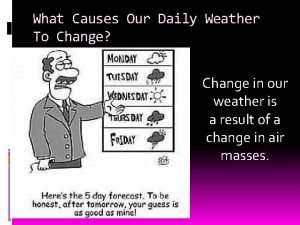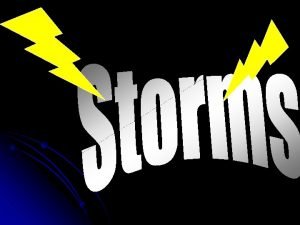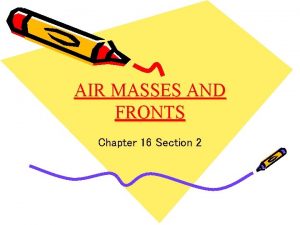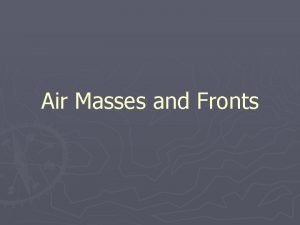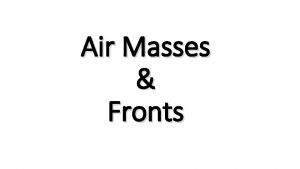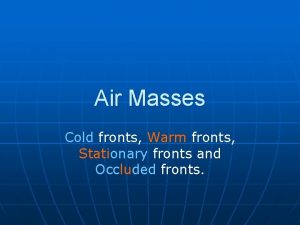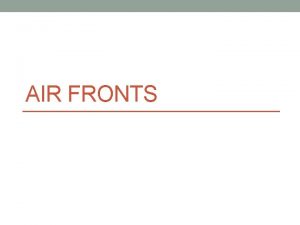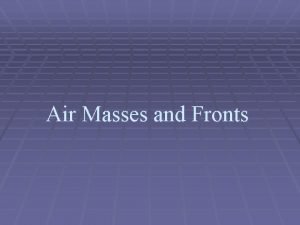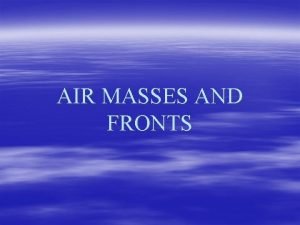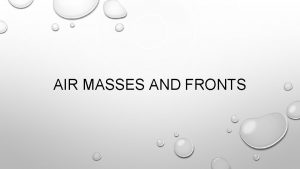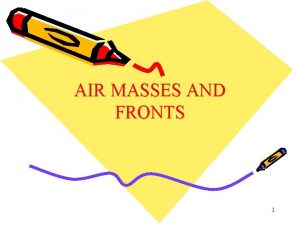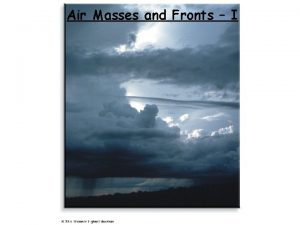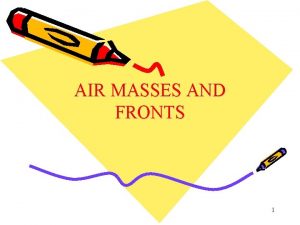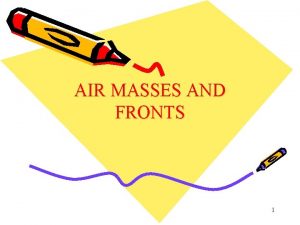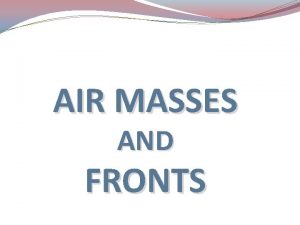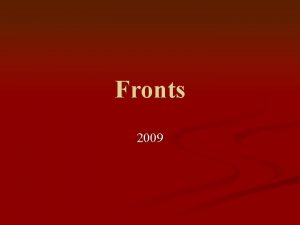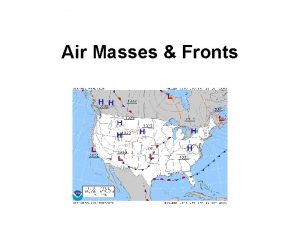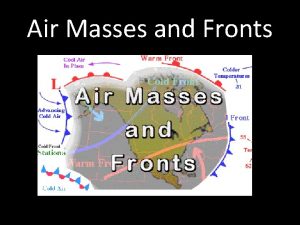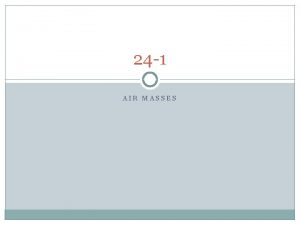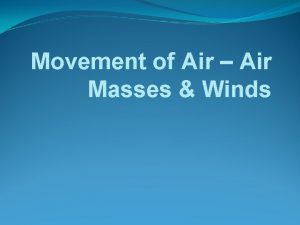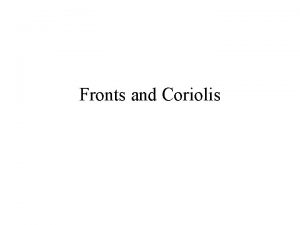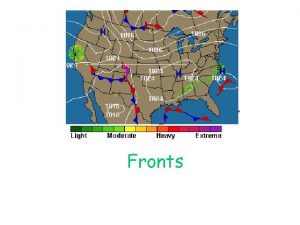Chp 9 Air Masses Fronts Fronts A FRONT




























- Slides: 28

Chp 9 Air Masses & Fronts

Fronts A “FRONT” is the intersection of air masses. “Mass” implies high pressure.

Source Regions • High or Low latitudes. • Not middle latitudes. • Middle latitudes are too variable & high pressure does not tend to develop & persist for long periods.

Source Characteristics • High & low latitudes. • 20, 000 or more km 2. • Several days required to form. • Develop in all seasons.

Air Mass Source, N Am. m. P c. A c. P c. T m. P 4 or 5 effect U. S. at once m. T

Air Mass Types • Continental • Maritime • Tropical • Polar • Arctic Of the 6 possibilities, only 5 can exist.

Arctic & Polar Air Masses large vertical Temp. gradient Arctic air is “freeze dried. ” 60°N 40°N

c. P Air Invades c. P tends to move South

Minn. Cools 36°F

Day 3, Alabama cools 18°F

m. T • develop over “warm” water • are not stable • develop thunderstorms • impact SW U. S. in El Niño. • become more unstable over land.

m. T vs m. P 1994 m. T moves N m. T dominates the SE U. S.

Convergence day 2

Day 3 14 -90 inch of snow

1995, 50 mph, 16”snow

Four Fronts • separate air masses of differing Temp. • cause uplift. • induce precip. • mix very slowly.

mid-latitude cyclone Usually cold & warm fronts. 2 -3 air masses.

Cold Front Stormy, slope backward, cumuliform clouds

Cold Front

Warm Front The boundary of warm air moving against cold air.

What’s wrong with this picture? Can you find 6 things ?

Overrunning Sometimes both masses move, warm overruns cold May bring heavy, general rain/snow.

Occlusion

Occlusion cont.

Alternative Occlusion Cyclonic low elongates to become a trough

Alternative Occlusion 2 No “side view” is given, (& perhaps is not known).

Dry Line c. P c. T m. T Where the dry air meets the moist.

1996
 Types of air masses
Types of air masses Air masses and fronts
Air masses and fronts Mt air mass
Mt air mass Why are cold fronts steeper than warm fronts
Why are cold fronts steeper than warm fronts Two cold air masses converge on a warm air mass
Two cold air masses converge on a warm air mass A swirling center of low air pressure is called
A swirling center of low air pressure is called Maritime polar
Maritime polar Air masses & frontswhat is an air mass?
Air masses & frontswhat is an air mass? Air masses & frontswhat is an air mass?
Air masses & frontswhat is an air mass? Air masses & frontswhat is an air mass?
Air masses & frontswhat is an air mass? What are the seven
What are the seven Stationary front
Stationary front Characteristics of air masses
Characteristics of air masses Types of air masses
Types of air masses What happens when 2 air masses meet
What happens when 2 air masses meet Stationary front
Stationary front Characteristics of fronts
Characteristics of fronts Source regions for air masses
Source regions for air masses Continental polar canadian air masses generally move
Continental polar canadian air masses generally move Air mass modification
Air mass modification Cyclogenesis occurs along the________.
Cyclogenesis occurs along the________. Air masses
Air masses Answer
Answer Area of low pressure where air masses meet and rise
Area of low pressure where air masses meet and rise Picture of occluded front
Picture of occluded front What are the five types of air masses?
What are the five types of air masses? Continental arctic air mass symbol
Continental arctic air mass symbol Brings drizzly rain
Brings drizzly rain Air masses
Air masses
